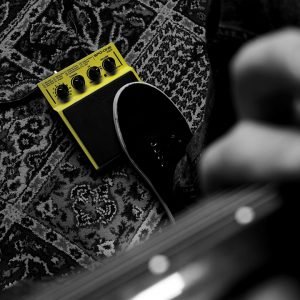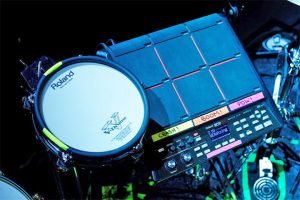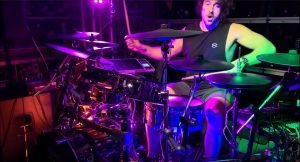Acoustic and electronic drums: you may have thought that the two never meet. Find out why the two camps actually strengthen each other
Music never stands still. It evolves at an alarming pace; new and old mashed-up to create completely new genres, sub-genres, and even micro-genres. Replicating all this recorded music on the live stage is challenging, with drummers having to work with acoustic drums and electronics to recreate the sound of the record. Enter the world of hybrid drums and find out why the future is about mixing it up.
You can’t have your cake and eat it, as the old saying goes. Why not though? Modern life is defined by choice, so it seems odd that a drummer would be ‘just’ acoustic or ‘just’ electronic. The technology within electronic drums, percussion and sampling technology has never been so powerful. Roland’s latest line-up of SuperNATURAL-powered V-Drums even behave like acoustic drums, while a realistic acoustic drum sound was achieved some time ago with Roland’s COSM technology. But for as long as this drummer can remember, acoustic percussion and electronics have been opposing factions. It’s always been a choice: A or B. Sure, acoustic drummers might play an electronic kit, but never would the two be played together.
Times are changing though. The musical lines between acoustic and electronic are being worn away by musicians who refuse to confine their creativity to a single genre or style. The power to create music and to take control of more than just percussion is now firmly in the hand of the drummer thanks to the hybrid kit; a blend of traditional acoustic drums and electronic percussion and sampling instruments in one playable, impressive kit. Hybrid kits represent the coming of age of the modern drummer. Here, we explore the roots of the movement and hybrid’s shift into the mainstream.
New Wave, synthpop, hip-hop, house, electro, pop… the late 70s and early 1980s produced some classic music. Not all of it was great, sure, but at the time a lot of that music was breakthrough. Music technology, recording processes, the microchip, the synth: all gave rise to new music and new ways of creating it. But, as a drummer, had I have been working in music in the early-mid 80s (I wasn’t, I was only five in 1984) I might have been feeling a little unsettled on my drummer’s throne. Because while the acoustic drum kit and the drummer were still prevalent, there were composers that had no need for the skills of a drummer. Hip-hop, house, electro, the pop-for-the-masses of Stock Aitken Waterman, all this music was partially defined by the sound of the drum machine and the synthesized drum.
Synthesized drum sound from the 808
Consider a band like Kraftwerk. Why would the group go to the trouble and expense of hiring a drummer, getting them to learn the track, choose the right drums, tune them, have them play along to a click and then have to spend hours on mixing when they could simply program a TR-808 Rhythm Composer to do exactly the same? It was so much more than that though, because the TR-808 provided a fresh synthesized drum sound that helped to make the music, even define it. But it was a sound that an acoustic drummer couldn’t make. At the time, the future of where the drummer would fit into contemporary music may have looked uncertain.
That was until the advent of the electronic drum kit. Many professional session drummers made the switch, as it was the way to continue to get work and make money. For the artists that hired them, the sound was electronic, but they still had the natural feel of a drummer and the visual aspect of a drummer on stage. The futurist look of early electronic drum kits even added to the stage show. But there was definite segregation there; it was electronic drums, or it was acoustic drums. As the 1980s drew to a close, electronic drums and the drum machine became the mainstay of acid house, electro, breakbeat, techno and the emerging dance and rave scenes, while mainstream (chart based) music’s love affair with the electronic drum kit had faded slightly, when acts favoured acoustic drums once again for their look and sound. From the late 90s the lines between what was ‘band’ (read acoustic) and what was ‘dance’ (read electronic) music became blurred. By 1997, it was accepted that indie fans would also own a repertoire of dance music. Leftfield, The Prodigy, The Chemical Brothers and Orbital became ‘rock n’ roll’ and were the poster boys of mainstream dance, even with their roots clearly in the house and rave scene (with the notable exception of Norman Cook AKA Fatboy Slim, who started his musical career as a drummer in a punk band). These artists were now well-versed in sampling acoustic drums, cymbals and percussion, while drum and bass artists, such as Roni Size and Asian Dub Foundation took it a step further and were using acoustic drums in the studio and on the stage. Meanwhile, pop acts of the time, such as The Spice Girls, Robbie Williams, Westlife and Sugababes, all started to include a dance element by adding electronic drum loops and samples, which would sit alongside an acoustic drum track. The fans would expect to see and hear the album in the live arena shows as they would on CD, without miming. The stage show had to ‘sound like’ the album – from tempo to the actual sounds and samples on the record. In many cases, Musical Directors would want everything from the exact drum sound and samples, track by track as it appeared on the album, to be replicated on the stage. Much of this would be down to the acoustic drummer to perform.
 Mixing electronic percussion into your acoustic setup
Mixing electronic percussion into your acoustic setup
Drummers had to become technical – to introduce electronic percussion and sampling playback systems into their acoustic rigs. On the professional circuit, electronic drums, pads and samplers were becoming as essential to the gig as the snare drum and hi-hats. For professional drummers like Steve White, Andy Gangadeen and Steve Barney, being a hybrid drummer meant the difference between working and not.
It wasn’t exclusively the pop and session circuit that saw acoustic drums and electronic kits sit side-by-side either. The US glam metal and thrash metal bands, such as Mötley Crüe, had been triggering their acoustic drums with electronic kick and snare sounds for some time, for a full-force sound in gigantic outdoor stadiums that otherwise would have been lost by using microphones alone. Drummer Neil Peart of Canadian proggers Rush has been using Roland V-Drums within his live acoustic drum set-up for over 10 years now, creating a truly ‘hybrid’ set-up, with clear advantages:
“I first introduced Roland V-Drums into my setup in 2001. They became a fixture in my drum solos, as well as to trigger samples throughout our live show. V-Drums have continued to improve in touch sensitivity, and in sound quality and variety, and I still find them not only fun to play, but a great creative addition to my percussion world.”
Today, we can revel in musical experimentation. Urban meets rock, blues meets dance, jazz meets hip-hop. The more creative we become as musicians, the greater the need for electronic and acoustic instruments to work in harmony. We have the technology, we have the inspiration and the barriers of ‘what is’ and ‘what isn’t’ have been broken down. The hybrid drum setup allows drummers to stay in control of percussion, to harness untold creativity with a wider range of sound and the ability to sample and trigger at will. At long last, the everyday drummer has the power and technology without the need for a back-up crew of technicians. As someone once said, now you can have your cake and eat it.









